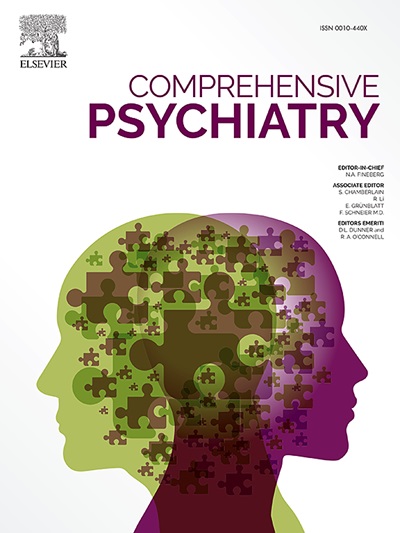Unravelling early transdiagnostic dynamics of psychotic-like experiences in young adults: Results from a cross-lagged panel network analysis
IF 4.2
2区 医学
Q1 PSYCHIATRY
引用次数: 0
Abstract
Background
Psychotic-like experiences (PLEs) are potential transdiagnostic markers of psychopathology. However, temporal patterns of associations between PLEs and other symptoms remain unclear. Moreover, it needs to be clarified as to whether PLEs might be primary targets for interventions. This study aimed to investigate longitudinal associations of PLEs with other psychopathological symptoms.
Methods
A total of 1314 young adults (aged 29.3 ± 5.7, 49.2 % women) without a lifetime history of psychiatric treatment completed online assessments, measuring psychopathological symptoms, at baseline and after 6 months. A cross-lagged panel network was analyzed. Output (the sum of edge weights from a specific node to all other nodes) and input (the sum of edge weights to a specific node from all other nodes) centralities were estimated. Age, gender, education, employment, and place of residence were the covariates.
Results
The highest output centrality was found for PLEs while the highest input centrality was observed for obsessive-compulsive symptoms. Centrality metrics of these symptom domains were significantly higher compared to centrality metrics of other psychopathological domains. PLEs showed cross-lagged associations with all other symptom domains. The strongest cross-lagged edge in the network led from PLEs to obsessive-compulsive symptoms (weight = 0.611). It was significantly stronger compared to all other cross-lagged edges in the network. The results were partially replicated in the network of specific symptoms.
Conclusions
The findings indicate that PLEs might precede the emergence of other domains of psychopathology. The highest output centrality of PLEs suggests their potential utility as primary targets for early interventions.
揭示年轻人精神病样经历的早期跨诊断动力学:来自交叉滞后面板网络分析的结果
背景类精神病体验(PLEs)是精神病理学的潜在跨诊断标记。然而,类精神病体验与其他症状之间的时间关联模式仍不清楚。此外,PLEs是否可能成为干预措施的主要目标也有待澄清。本研究旨在调查 PLEs 与其他精神病理症状的纵向关联。方法共有 1314 名无精神病治疗史的年轻人(年龄为 29.3 ± 5.7,49.2% 为女性)在基线和 6 个月后完成了在线评估,测量精神病理症状。对交叉滞后的面板网络进行了分析。对输出(从特定节点到所有其他节点的边缘权重总和)和输入(从所有其他节点到特定节点的边缘权重总和)中心性进行了估算。结果 PLEs 的输出中心度最高,而强迫症状的输入中心度最高。这些症状领域的中心度指标明显高于其他精神病理学领域的中心度指标。PLE 与所有其他症状领域都存在交叉滞后关联。网络中最强的交叉滞后边是从 PLEs 指向强迫症状(权重 = 0.611)。与网络中的所有其他交叉滞后边缘相比,它明显更强。结论研究结果表明,PLEs 可能先于其他精神病理学领域的症状出现。PLEs 的最高输出中心性表明,它们可能是早期干预的主要目标。
本文章由计算机程序翻译,如有差异,请以英文原文为准。
求助全文
约1分钟内获得全文
求助全文
来源期刊

Comprehensive psychiatry
医学-精神病学
CiteScore
12.50
自引率
1.40%
发文量
64
审稿时长
29 days
期刊介绍:
"Comprehensive Psychiatry" is an open access, peer-reviewed journal dedicated to the field of psychiatry and mental health. Its primary mission is to share the latest advancements in knowledge to enhance patient care and deepen the understanding of mental illnesses. The journal is supported by a diverse team of international editors and peer reviewers, ensuring the publication of high-quality research with a strong focus on clinical relevance and the implications for psychopathology.
"Comprehensive Psychiatry" encourages authors to present their research in an accessible manner, facilitating engagement with clinicians, policymakers, and the broader public. By embracing an open access policy, the journal aims to maximize the global impact of its content, making it readily available to a wide audience and fostering scientific collaboration and public awareness beyond the traditional academic community. This approach is designed to promote a more inclusive and informed dialogue on mental health, contributing to the overall progress in the field.
 求助内容:
求助内容: 应助结果提醒方式:
应助结果提醒方式:


